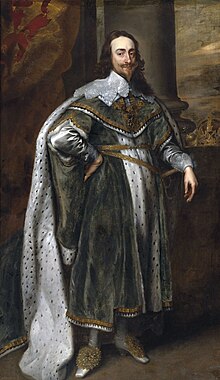Charles I (England)
| Charles I | |
|---|---|

Portrait from the studio of Anthony van Dyck, 1636
|
|
| King of England and Ireland (more...) | |
| Reign | 27 March 1625 – 30 January 1649 |
| Coronation | 2 February 1626 |
| Predecessor | James I |
| Successor |
Charles II (de jure) Council of State (de facto) |
| King of Scotland (more...) | |
| Reign | 27 March 1625 – 30 January 1649 |
| Coronation | 18 June 1633 |
| Predecessor | James VI |
| Successor | Charles II |
| Born | 19 November 1600 Dunfermline Palace, Dunfermline, Scotland |
| Died | 30 January 1649 (aged 48) Whitehall, London |
| Burial | 9 February 1649 St George's Chapel, Windsor Castle, England |
| Spouse | Henrietta Maria of France |
| Issue Detail |
|
| House | Stuart |
| Father | James VI of Scotland and I of England |
| Mother | Anne of Denmark |
| Religion | Anglican |
Charles I (19 November 1600 – 30 January 1649) was monarch of the three kingdoms of England, Scotland, and Ireland from 27 March 1625 until his execution in 1649.
Charles was the second son of King James VI of Scotland, but after his father inherited the English throne in 1603, he moved to England, where he spent much of the rest of his life. He became heir apparent to the English, Irish, and Scottish thrones on the death of his elder brother, Henry Frederick, Prince of Wales, in 1612. An unsuccessful and unpopular attempt to marry him to the Spanish Habsburg princess Maria Anna culminated in an eight-month visit to Spain in 1623 that demonstrated the futility of the marriage negotiations. Two years later, he married the Bourbon princess Henrietta Maria of France instead.
After his succession, Charles quarrelled with the Parliament of England, which sought to curb his royal prerogative. Charles believed in the divine right of kings and thought he could govern according to his own conscience. Many of his subjects opposed his policies, in particular the levying of taxes without parliamentary consent, and perceived his actions as those of a tyrannical absolute monarch. His religious policies, coupled with his marriage to a Roman Catholic, generated the antipathy and mistrust of reformed groups such as the English Puritans and Scottish Covenanters, who thought his views too Catholic. He supported high church ecclesiastics, such as Richard Montagu and William Laud, and failed to aid Protestant forces successfully during the Thirty Years' War. His attempts to force the Church of Scotland to adopt high Anglican practices led to the Bishops' Wars, strengthened the position of the English and Scottish parliaments and helped precipitate his own downfall.
...
Wikipedia
